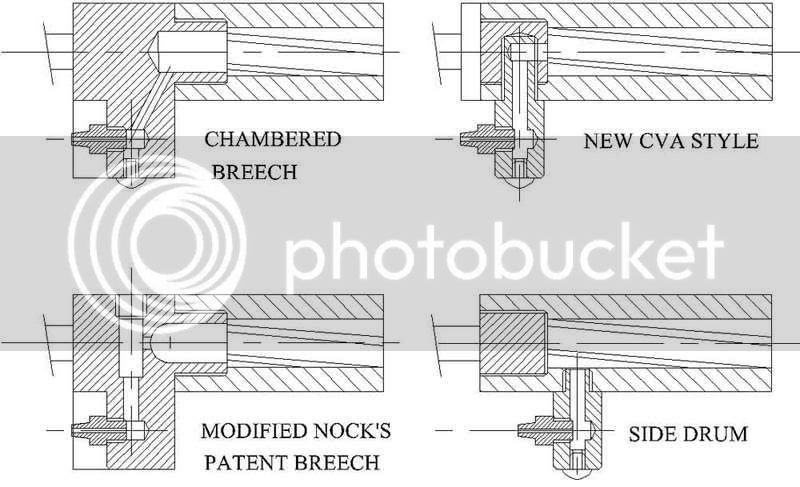I'll say that I like the old side drum ignition.
It's drawn in the lower right hand area in this sketch
I've never had a problem with one of these side drums however I have had mis-fires and slow fires with both the Chambered breech and the CVA Patent breechs.
I attribute these to the long flame channel the caps flame must travel thru if some powder from the main powder charge isn't blown back thru it to rest near the bottom of the nipple.
As can be seen in the sketch, the CVA patent breech is somewhat similar to Nock's Patent breech in that the newly loaded powder must travel thru a fairly small hole to begin to approach the bottom of the nipple.
Admittedly, the powder has to travel thru a fairly small hole in a side drum before getting to the bottom of the nipple but the distance is seldom over 3/4" and usually more like 1/2".
About the only weak part of the side drum system is in poorly made rifles/pistols. In these poorly made guns the drum is left standing proud of the lock plate. That is to say, it is not making contact with it.
In this condition, the threads must absorb all of the hammers energy and the threads can shear off from the impact.
Properly made, the side drum is not "standing alone" and relying on the threads to take the force of the hammer blow.
The underside of the drum should be in contact with the lockplate when the barrel is installed into the stock so that the force of the hammer blow is conveyed thru the nipple to the drum and thru the drum directly into the side plate.
Installed this way there is no energy directed thru the threads into the barrel so there is no concern about the threads shearing off.
Side drums have been used for over 175 years and many original guns are still functioning fine.
There are those who say the guns fitted with a chambered breech or Patent breech shoot "harder" or cleaner and this was the goal of Nock when he first came up with the idea.
Nock's idea was that the small cross-ways chambers powder would create a jet of flame that would travel thru the main powder charge and give a faster, more thorough ignition. Tests seemed to agree with this but I have never noticed a difference with Manton's Chambered style breeches.
I will admit that I've never owned a real Nock's Patent style breached gun but in order for one of these to work well quite a bit of the main charge must end up in the small chamber behind the bore and it seems to me that filling this chamber could be as difficult as filling the long flame channel in a chambered breech.

